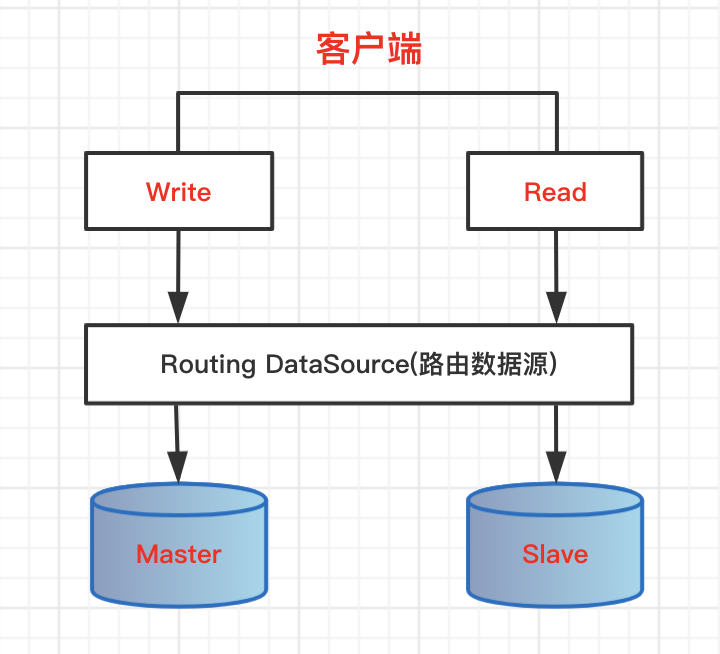数据源管理 | 主从库动态路由,AOP模式读写分离
2020-04-01 16:04:53来源:博客园 阅读 ()

数据源管理 | 主从库动态路由,AOP模式读写分离
本文源码:GitHub·点这里 || GitEE·点这里
一、多数据源应用
1、基础描述
在相对复杂的应用服务中,配置多个数据源是常见现象,例如常见的:配置主从数据库用来写数据,再配置一个从库读数据,这种读写分离模式可以缓解数据库压力,提高系统的并发能力和稳定性,执行效率。

2、核心API
在处理这种常见问题,要学会查询服务基础框架的API,说直白点就是查询Spring框架的API(工作几年,还没用过Spring之外的框架搭建环境),这种常用的业务模式,基本上Spring都提供了API支持。
核心API:AbstractRoutingDataSource
底层维护Map容器,用来保存数据源集合,提供一个抽象方法,实现自定义的路由策略。
@Nullable
private Map<Object, DataSource> resolvedDataSources;
@Nullable
protected abstract Object determineCurrentLookupKey();
补刀一句:为何框架的原理很难通过一篇文章看明白?因为使用的不多,基本意识没有形成,熟悉框架原理的基本要求:对框架的各种功能都熟悉,经常使用,自然而然的就明白了,盐大晒的久,咸鱼才够味。
二、数据源路由
1、数据源管理
配置两个数据源
spring:
datasource:
type: com.alibaba.druid.pool.DruidDataSource
driverClassName: com.mysql.jdbc.Driver
master:
url: jdbc:mysql://localhost:3306/data_master
username: root
password: 123456
slave:
url: jdbc:mysql://localhost:3306/data_slave
username: root
password: 123456
从实际开发角度,这两个数据源需要配置主从复制流程,再基于安全角度,写库可以只给写权限,读库只给读权限。
Map容器加载
@Configuration
public class DruidConfig {
// 忽略参数加载,源码中有
@Bean
@Primary
public DataSource primaryDataSource() {
Map<Object, Object> map = new HashMap<>();
map.put("masterDataSource", masterDataSource());
map.put("slaveDataSource", slaveDataSource());
RouteDataSource routeDataSource = new RouteDataSource();
routeDataSource.setTargetDataSources(map);
routeDataSource.setDefaultTargetDataSource(masterDataSource());
return routeDataSource ;
}
private DataSource masterDataSource() {
return getDefDataSource(masterUrl,masterUsername,masterPassword);
}
private DataSource slaveDataSource() {
return getDefDataSource(slaveUrl,slaveUsername,slavePassword);
}
private DataSource getDefDataSource (String url,String userName,String passWord){
DruidDataSource datasource = new DruidDataSource();
datasource.setDriverClassName(driverClassName);
datasource.setUrl(url);
datasource.setUsername(userName);
datasource.setPassword(passWord);
return datasource;
}
}
这里的Map容器管理两个key,masterDataSource和slaveDataSource代表两个不同的库,使用不同的key即加载对应的库。
2、容器Key管理
使用ThreadLocal管理当前会会话中线程参数,存取使用极其方便。
public class RouteContext implements AutoCloseable {
private static final ThreadLocal<String> threadLocal = new ThreadLocal<>();
public static void setRouteKey (String key){
threadLocal.set(key);
}
public static String getRouteKey() {
String key = threadLocal.get();
return key == null ? "masterDataSource" : key;
}
@Override
public void close() {
threadLocal.remove();
}
}
3、路由Key实现
获取ThreadLocal中,当前数据源的key,适配相关联的数据源。
public class RouteDataSource extends AbstractRoutingDataSource {
@Override
protected Object determineCurrentLookupKey() {
return RouteContext.getRouteKey();
}
}
三、读写分离
1、AOP思维
基于AOP的切面思想,不同的方法类型,去设置对应路由Key,这样就可以在业务逻辑执行之前,切换到不同的数据源。
Aspect
@Component
@Order(1)
public class ReadWriteAop {
private static Logger LOGGER = LoggerFactory.getLogger(ReadWriteAop.class) ;
@Before("execution(* com.master.slave.controller.*.*(..))")
public void setReadDataSourceType() {
HttpServletRequest request = ((ServletRequestAttributes) RequestContextHolder.getRequestAttributes()).getRequest();
String method = request.getRequestURI() ;
boolean rwFlag = readOrWrite(method) ;
if (rwFlag){
RouteContext.setRouteKey("slaveDataSource");
} else {
RouteContext.setRouteKey("masterDataSource");
}
LOGGER.info("请求方法:"+method+";执行库:"+RouteContext.getRouteKey());
}
private String[] readArr = new String[]{"select","count","query","get","find"} ;
private boolean readOrWrite (String method){
for (String readVar:readArr) {
if (method.contains(readVar)){
return true ;
}
}
return false ;
}
}
常见的读取方法:select、count、query、get、find等等,方法的命名要遵循自定义的路由规则。
2、提供测试接口
控制层API
import com.master.slave.entity.User;
import com.master.slave.service.UserService;
import org.springframework.web.bind.annotation.GetMapping;
import org.springframework.web.bind.annotation.RequestParam;
import org.springframework.web.bind.annotation.RestController;
import javax.annotation.Resource;
@RestController
public class UserController {
@Resource
private UserService userService ;
@GetMapping("/selectById")
public User selectById (@RequestParam("id") Integer id) {
return userService.selectById(id) ;
}
@GetMapping("/insert")
public String insert () {
User user = new User("张三","write") ;
userService.insert(user) ;
return "success" ;
}
}
服务实现
@Service
public class UserService {
@Resource
private UserMapper userMapper ;
public User selectById (Integer id) {
return userMapper.selectById(id) ;
}
public void insert (User user){
userMapper.insert(user);
}
}
这样数据源基于不同的类型方法就会一直的动态切换。
四、源代码地址
GitHub·地址
https://github.com/cicadasmile/data-manage-parent
GitEE·地址
https://gitee.com/cicadasmile/data-manage-parent

原文链接:https://www.cnblogs.com/cicada-smile/p/12610151.html
如有疑问请与原作者联系
标签:
版权申明:本站文章部分自网络,如有侵权,请联系:west999com@outlook.com
特别注意:本站所有转载文章言论不代表本站观点,本站所提供的摄影照片,插画,设计作品,如需使用,请与原作者联系,版权归原作者所有
上一篇:设计模式-代理模式
下一篇:Eclipse快捷键大全
- 数据源管理 | Kafka集群环境搭建,消息存储机制详解 2020-06-11
- SpringBoot + Vue + ElementUI 实现后台管理系统模板 -- 后 2020-06-10
- MyBatis整合双数据源 2020-06-04
- 数据分析 | 基于智能标签,精准管理数据 2020-05-30
- JSP+SSM+Mysql实现的图书馆预约占座管理系统 2020-05-26
IDC资讯: 主机资讯 注册资讯 托管资讯 vps资讯 网站建设
网站运营: 建站经验 策划盈利 搜索优化 网站推广 免费资源
网络编程: Asp.Net编程 Asp编程 Php编程 Xml编程 Access Mssql Mysql 其它
服务器技术: Web服务器 Ftp服务器 Mail服务器 Dns服务器 安全防护
软件技巧: 其它软件 Word Excel Powerpoint Ghost Vista QQ空间 QQ FlashGet 迅雷
网页制作: FrontPages Dreamweaver Javascript css photoshop fireworks Flash
